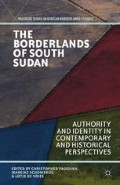Abstract
This chapter discusses the borderland between Southern Darfur and Northern Bahr el-Ghazal under Anglo-Egyptian (de facto British colonial) administration. This borderland has since 2011 become the site of a (heavily disputed) international boundary, but during the Condominium and until the independence of South Sudan it was a dividing line between provinces of northern and southern Sudan, which was also imagined by state officials as a “tribal”—and indeed racial—boundary between pastoralist Rizeigat Baqqara (Arabs) and Malual Dinka (non-Arabs). The boundary became especially significant with the colonial government’s introduction of the “Southern Policy” in 1930, often interpreted by colonial officials and historians as an attempt to restrict contact between what was imagined to be the Arab, Islamic north of Sudan and the non-Arab, non-Islamic south. But contact between the two peoples, despite the strictures of the Southern Policy, was inevitable, as the border was close to the river called Bahr el-Arab (in Arabic) or the Kür (in Dinka), which, together with the land and waterways around it, was a crucial grazing and watering resource for both these cattle-keeping peoples. Managing the resultant overlapping patterns of resource use was a key challenge for the Darfur and Bahr el-Ghazal administrations.
Access this chapter
Tax calculation will be finalised at checkout
Purchases are for personal use only
Preview
Unable to display preview. Download preview PDF.
Notes
Douglas Johnson, When Boundaries Become Borders (London: Rift Valley Institute, 2010), 112.
Douglas Johnson, “Tribal Boundaries and Border Wars: Nuer–Dinka Relations in the Sobat and Zaraf Valleys, c. 1860–1976.” Journal of African History 23 (1982): 183–203, uncovers similar processes of administrators being drawn into taking sides in intercommunity disputes.
See also Dorothy Hodgson, Once Intrepid Warriors: Gender, Ethnicity and the Cultural Politics of Maasai Development (Bloomington: Indiana University Press, 2001), 60;
Gaim Kibreab, State Intervention and the Environment in Sudan, 1889–1989: The Demise of Communal Resource Management (Lewiston, NY: Edwin Mellen Press, 2002), 51.
Douglas Johnson, “Decolonising the Borders in Sudan,” in Empire, Development and Colonialism: The Past in the Present, eds Mark Duffield and Vernon Hewitt (Oxford: James Currey, 2009), 180–182; Kibreab, State, 80–100.
Jon Abbink, “The Shrinking Cultural and Political Space of East African Pastoral Societies.” Nordic Journal of African Studies 6 (1997): 1.
See also Hodgson, Warriors, esp. 49–55; Richard Waller, “Pastoral Poverty in Historical Perspective,” in The Poor Are Not Us, eds David Anderson and Vigdis Broch-Dur (Oxford: James Currey, 1999), 40;
Pierre Boilley, “Administrative Confinements and Confinements of Exile: The Reclusion of Nomads in the Sahara,” in A History of Prison and Confinement in Africa, ed. E Bernault (Portsmouth, NH: Heinemann, 2003), 224–226;
David Anderson, Eroding the Commons: The Politics of Ecology in Baringo, Kenya 1890–1963 (Oxford: James Currey, 2002). Kibreab’s account of the Malual–Rizeigat case also emphasizes that boundary and grazing settlements were agreed by DCs and imposed on the tribes. State, 80–100.
For example, Fekadu Adugna, “Making Use of Kin beyond the International Border: Inter-Ethnic Relations among the Ethio–Kenyan Border,” 48–52; and Lee Casanelli, “The Opportunistic Economies of the Kenya–Somalia Borderland in Historical Perspective,” 135, 146, both in Boundaries and Borderlands As Resources in the Horn of Africa, eds Dereje Feyissa and Markus Hoehne (Oxford: James Currey, 2011).
MacMichael, “Memorandum on Southern Policy”, enclosed in Civil Secretary to Southern Governors, January 25, 1930, appended in Mudaththir Abdel Rahim, Imperialism and Nationalism in the Sudan: A Study in Constitutional and Political Development 1899–1956 (Oxford: Clarendon Press, 1969), 244–249.
Paul Nugent and Anthony Asiwaju, eds, “The Paradox of African Boundaries,” in African Boundaries: Barriers, Conduits and Opportunities (London: Pinter, 1996), 2.
For example, Justin Willis, “Hukm. The Creolization of Authority in Condominium Sudan.” Journal of African History 46 (2005): 29–50.
Cf. Timothy Mitchell, “The Limits of the State: Beyond Statist Approaches and Their Critics.” American Political Science Review 85 (1991): 77–96, which focuses more on effects of distance than on effects of local interiority.
James Scott, Seeing Like a State (New Haven, CT: Yale University Press, 1994), 2–4.
Hastings Donnan and Thomas Wilson, “Introduction” in Borders: Frontiers of Identity, Nation and State, eds T. Wilson and H. Donnan (Oxford: Berg, 1999), 3–4;
Veena Das and Deborah Poole, eds, “State and Its Margins: Comparative Ethnographies,” in Anthropology in the Margins of the State (Oxford: James Currey, 2004), 1–33.
Editor information
Copyright information
© 2013 Christopher Vaughan, Mareike Schomerus, and Lotje de Vries
About this chapter
Cite this chapter
Vaughan, C. (2013). The Rizeigat—Malual Borderland during the Condominium: The Limits of Legibility. In: Vaughan, C., Schomerus, M., de Vries, L. (eds) The Borderlands of South Sudan. Palgrave Series in African Borderlands Studies. Palgrave Macmillan, New York. https://doi.org/10.1057/9781137340894_7
Download citation
DOI: https://doi.org/10.1057/9781137340894_7
Publisher Name: Palgrave Macmillan, New York
Print ISBN: 978-1-349-46498-2
Online ISBN: 978-1-137-34089-4
eBook Packages: Palgrave Political & Intern. Studies CollectionPolitical Science and International Studies (R0)

